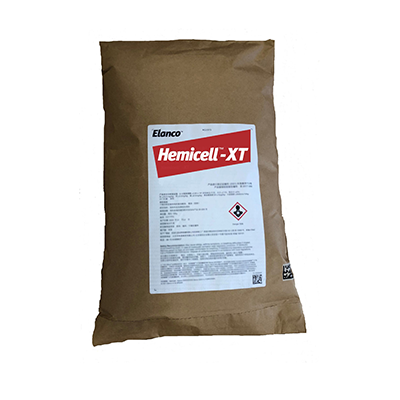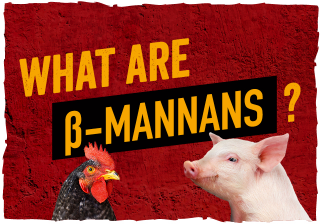Energy-sparing enzyme can deliver cost benefits to pig and poultry rations
The continued rise in input costs has highlighted the importance of making pig and poultry rations as cost-effective as possible. How can Hemicell™ XT, an energy-sparing enzyme play a role in achieving this?
Enzymes are becoming more popular in pig and poultry rations, to ensure any costly raw materials are utilised to their full benefit. As you’ll be aware, some nutrient-releasing enzymes – such as phytase and xylanase – are regularly used in monogastric rations to help break down substrates in feed to make more nutrients and energy available for growth and production. However, a newer type of energy-sparing enzyme, called β-mannanase, such as Hemicell™ XT, can be added to rations to mitigate the negative impacts of dietary β-mannans.
Why β-mannans pose a challenge
Dietary β-mannans are found in most plant-based raw materials, but can be problematic because of the physiological response they trigger in pigs and poultry species. β-mannans are complex, undigestible fibres made up of long-chain sugars that are difficult to break down. Their presence in feed often initiates a Feed-Induced Immune Response (FIIR), which triggers a series of detrimental physical and biological responses; as just 0.2% β-mannan concentration is needed to trigger a FIIR . As the threat is not actually there, the animal wastes energy and nutrients building up the immune response. In addition, the initiation of the immune response causes inflammation of the gut, which leads to even more wasted energy and nutrients.
How β-mannanase can help
The inclusion of Hemicell XT, a β-mannanase, in pig and poultry rations will combat the negative effects of β-mannans. The enzyme is used to tackle the unintended consequences of β-mannans – it basically degrades them and works immediately to turn these undigestible fibres into smaller sugars, which the immune system does not recognise as a threat. This delivers multiple benefits including better energy utilisation, which leads to the possibility to reduce the amount of energy in the diet and healthier pigs and poultry.
The cost saving will depend on the feed price and the amount of energy you want to reduce in the diet. However, we know that a FIIR can waste 3% of the energy in the diet – this equates to a 3% reduction in performance.
Being able to reduce the amount of energy in the diet offers nutritionists greater flexibility when formulating rations. The inclusion of β-mannanase is especially important if rations have been altered to include less expensive raw materials, which may contain higher levels of anti-nutritional factors such as β-mannans.
Pig rations and β-mannanase
The inclusion of enzymes in pig rations can deliver multiple benefits – cost-saving, improved gut health and environmental impact – says independent nutritionist Faye Murch, from Kingsgate Nutrition. Enzymes are becoming part of our everyday life in the nutrition world, and they need to be reviewed regularly. Our job as nutritionists is to try and grow animals as healthily, cost-effectively and sustainably as we can – and β-mannanase can help us do that. Pigs historically had access to a much more balanced diet, with protein sourced from insects, fungi, seeds, and berries. However, the amount of β-mannans they are now eating is much more than before – they are essentially on a vegetarian diet.
The use of β-mannanase can help by breaking down β-mannans in diets and presenting them into the animal’s body differently; this means the animal is not recognising them as a pathogen, avoiding the immune response, therefore not wasting valuable energy. The immune system should be ready to react at any point in time, but if it is already reacting to the β-mannans in the diet, it is going to have a little bit less energy to put towards a vaccine response, or an E. coli stress, for example. Meanwhile, the environmental benefits offered are delivered by using feed more efficiently and reducing the amount of lost nutrients – something that can lead to animals being finished sooner, or less inputs being required to finish them.
Lastly, cost-savings can be achieved by either using β-mannanase to reduce the amount of energy required in the diet, or to improve overall pig performance. You can use the enzyme if you’re looking to drop the energy of the diet because you are hoping to save some of the energy from the FIIR. However, the enzyme can also be used post-weaning to improve health which can result in extra weight at finishing, shorter days to finishing, or a better FCR.

Broiler rations and β-mannanase
The β-mannanase enzyme is used in broiler rations to tackle the negative physiological impact of β-mannans and to improve performance, says poultry nutritionist Eloise Lawlor from Premier Nutrition. Enzymes tend to be used in broiler rations to ensure birds get the most from the raw materials they are being fed. β-mannanase is used to break down β-mannans avoiding the FIIR thus allowing the birds to divert this saved energy into growth. With more cost pressure on producers, we need to make sure we are utilising the raw materials in diets to the best effect that we can. There is now much more variation in what we are using in rations in terms of cereals and proteins. This means it is important that we look at the use of enzymes and see what they can bring to the table, to make sure the bird utilises the raw materials in the best way they can.
What is β-mannanase?
- β-mannanase is an energy-sparing enzyme, commercially known as Hemicell™ XT
- It breaks down β-mannans, which are found in most plant-based raw materials in monogastric diets
- β-mannans are problematic because they trigger a Feed-Induced Immune Response (FIIR) whereby energy and nutrients are spent unnecessarily on the immune system because the β-mannans are mistaken by the pig or poultry as a pathogen threat
- Prevention of FIIR leads to improved production efficiency, improved gut health, and the ability to reduce the amount of energy present in the diet.
- Optimising gut health by neutralizing B-mannans in feed ingredients - FAQ. 2021. Elanco.

